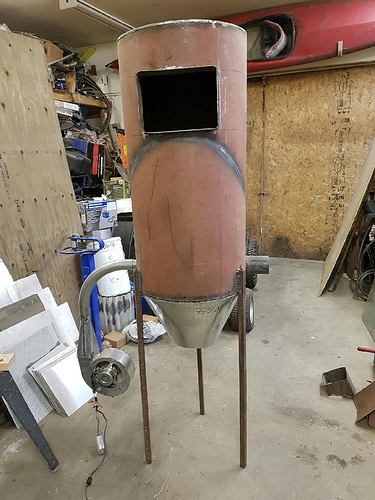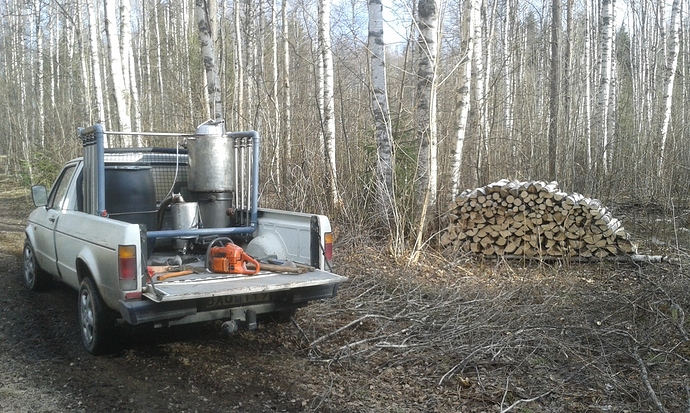HWWT ( have wood will travel )
Your wood chunk processing is on a whole different scale
I come back into the house for a sit down cup of coffee after making 4 or 5 buckets full!
That is a beautiful sight
Have you already chosen a model of stove in particular?
I am currently testing a stove to produce coal, to collect pyrolitic oil. I will build a heat exchanger to recover the btu lost in the exhaust gas. I would like to automate the loading of the wood. Ideally I want to heat my house, produce coal for the engines of my farm and biochar. It is a long-term project that I try to realize every day a little more
The idea of solving my energy needs without emitting co2 (carbon neutral). Or better in carbon positive (bury biochar ) motivates me enormously
Just starting to venture on my property this year. This is the other 40 acres where the Maple trees are. On this same parcel there are some decent sized Cedar. That’s a different video. This week I made a trail to access Maple trees for the sap.It will also serve as a logging trail.
What I really like is all the pesky little Poplar trees. Perfect size for my little gasifier. This is my oil field for the future.
Your getting some real nice trails built there bill, and you really got a lot done in short order, soon you will be finding time too dow and have some good logging trails too supply your vehicles, and heat sourse when needed, nice job when you get caught up it might seem like you retired. And will have a very nice place too retire too the new way of life.Farm Out Man.
Hi Thierry. Sorry for taking this long to respond. I have been working on a project, but it’s been stalled for quite a while. Essentially it’s a downdraft gasifier, meant to (hopefully) burn coarser chunk wood, reducing it to charcoal which will drop for storage. The fan is an ejector system to draw wood gas from slots in the bottom of the larger pipe, to be burnt in a refractory lined swirl burn chamber, then passed through a heat exchanger. The grate has a fixed, and a moveable part, to shake charcoal through, it would be stroked on a periodic cycle.
I think the concept is sound, but my design and execution may not be effective, as there has been no calculated design. At least it’s something to work with and learn from.
The tube is a Chinese steel coil liner, 20 1/2" diameter, 11ga, which allows using a steel barrel as either an insulation jacket or for air preheat.
.Hi Garry
Why did you choose a poel gasifier instead of a cooking oven ?
I can not imagine how to manage the extraction of coal from the zone of combustion continuously and automatically
By shaking the ash grid very strong, incompletely carbonized wood risks to pass from the coal side
Reversely by shaking too little, coal will be burned
Walking the dogs the other day I discovered a tall birch tree down. I fired up the Rabbit this morning, brought all the limbs home and chunked them.
I already completed firewood and stored away all equipment the other week. I decided to go back and do it Garry’s way with only chainsaw and splitting axe. Wonderful work splitting while listening to the birds singing and the best exercise there is.
Thierry, my theory is that the size of the grate openings will govern to a degree how quickly, and what size of char passes through. But a stationary system will need some sort of grate movement or external vibration. What I am building is a fixed coarse grate of vertical 3/8" steel, with a moveable grate above sliding on it. The moveable grate is actuated by a rod through the side. The moveable grate will be made from inverted stainless steel angles, as per Max’s advice, to trap insulating ash, and radiate the destructive heat.
I think this arrangement will allow finer char to slip through for collection, and coarser material can be broken by the grate action.
Regards,
Hi, Garry!
18.4.2017
If you want maximum utiliation of the char, do not use bar groups making “scissors”-action!
Keep the char above both groups. No less than 90 degrees above the groups to avoid “scissorsing”.
If you want spoiling char, then go for scissors action…
I just got back late this evening from living that same dream the last couple of days. The wood frogs have thawed out and are singing. The sandhill cranes are back up on my land, calling and flying timeless courtship rituals. Curious red tailed hawk and raven. My dog doesn’t approve… But I do. To appreciate and observe nature that way requires hours and days in the bush. Working wood with basic tools is the best exercise. I worry that skill with an axe is almost a dying art.
Regards,
I am trying this approach to try to achieve a continuous process. An oven or retort process is a batch process, and releases a large amount of heat with little ability to regulate. That will lead to system complexity, for heating needs a large thermal mass, water, will be needed to absorb the vast amount of heat. The gasification systems can also be regulated for greater or lesser energy output without reduction in quality of gas / char.
Up until 10 years ago I split all my annual 6-7 cord with axe only. The very last year I did that I had to cut a 5 year supply one single spring because all wood lots were beeing rearanged and felling was not allowed during that period. Ever since I’ve had a sore neck every time I overdo things. Small batches like these are ok and much more enjoyable 
Wow. That’s a lot of wood, and a level of regulation unknown over here, but our wood resources are hardly strained. Even bulldozing of standing forest and bluffs for farming isn’t regulated, which is too little regulation, I feel…
Working fuel wood largely by hand is very demanding work. Like all exercise it can easily be overdone, especially as one gets older.  especially in the winter, when people tend to be not in highest physical shape.
especially in the winter, when people tend to be not in highest physical shape.
On the other hand, splitting in lengths on the ground is arguably easier than using a hydraulic splitter, as there’s no need to bring all the wood to one machine, and then lift it all. Besides, here that means fighting with the snow. That was the origin of the system, pioneers aimed for maximum ease, and minimum work.
Hi Garry
I am very anxious to see the evolution of your project. I have built a retort process (wood baking oven) and I now face the challenge of burning the gas well and recover the BTU
My strategy for managing the flow of gas from the wood baking oven is to try to divert some of the gas to another burner (boiler). The idea is to control the temperature of the pyrolysis to stretch it over time.
In other words, gradually cupping the wood, to regulate the gradual release of pyrolysis vapors
Now that’s a beast!
The amount of power that must take…
Regarding bulldozing a forest:
A guy bought a mostly tillable 40 from us 2 years ago and decided that he would cut down the 3 acre woods on the corner of it. They had some guy come in and drop all the trees by cutting in at a 45 degree down angle from each side towards the center. He simply kept going with the second cut until the tree fell over. This process barber-chaired about half of them. What mess. You couldn’t even walk through it. Trees scattered everywhere, like after a tornado.
Well, he offered a me a few logs, mostly 40 year old black walnut and I took them.
Then he rented a huge end loader and started pushing and dragging all the remaining trees into piles. After that one guy came in and worked the piles over a little for firewood and a few slabs, He used a really long-bar chain saw mill. But he quit because of all the dirt and mud on the trees from the bulldozing kept dulling his chains. He told me that even carbide chains quit cutting! Now, no one even wants to make firewood out of the rest. I guess that’s the point of this post. All that’s left, as far as I can see is to burn it where is sits. And no, he still hasn’t grubbed out the stumps.
Pete Stanaitis
What a shame to even cut down Black Walnut.



